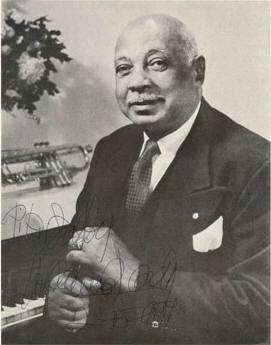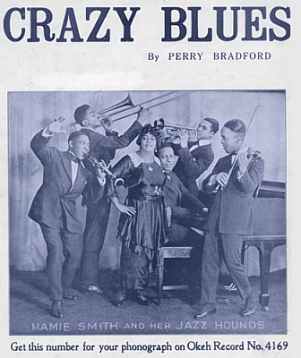|
THE FIRST BLUES RECORDINGS The more I get into the blues, the more I become interested in the roots. So recently, I spent some time researching the subject and found some interesting results.. A big surprise was learning that Mamie Smith, touted for many years in most blues history books as the first person to record blues, wasn’t even second or third. By the time she recorded Crazy Blues in 1920, there had been numerous recordings made with “blues” in the title. But let’s go back to the beginning. In 1902, singer Gertrude “Ma” Rainey was touring Missouri with a minstrel tent show when a girl came into her tent and started singing about the man who left her. The song was so strange and poignant; it attracted a lot of attention. When Ma asked her what it was, she said, “the blues”. Then there’s W.C. Handy’s story. In 1903, he was a traveling musician waiting for a train in Tutwiler, Mississippi, when he heard a young man, dressed in rags and playing a beat up guitar with a knife blade, singing “Goin’ where the Southern crosses the Yellow Dog”. (The Southern and the Yellow Dog were railroad lines.) The song, in three twelve-bar stanzas, intrigued Handy and he never forgot it. | ||
 A few years later, Handy was leading a minstrel band in
Memphis when he was approached by the political handlers of a candidate for
Mayor named Mr. Crump. A few years later, Handy was leading a minstrel band in
Memphis when he was approached by the political handlers of a candidate for
Mayor named Mr. Crump.
They asked Handy to write a song to promote their candidate. | ||
|
Handy’s band played Mr. Crump on the corner of Main & Madison streets, and it stopped traffic. “Stenographers danced with their bosses. Men ran up and wanted to know, ‘what’s the name of that song?’ We had to play it over and over,” Handy recalled. “Mr. Crump got elected and it got so that if a band couldn’t play Mr. Crump, they couldn’t get a job.” Later, Handy published the song and since Mr. Crump had become the boss of Tennessee politics, he had to change the name, so he called it the “Memphis Blues.” It was the first published blues song according to Handy, but further research has proved otherwise. The first blues song published was called “I Got The Blues”. It was a ragtime blues, written by Anthony Maggio and published in 1908. The second blues song published was the “Dallas Blues” written by Hart Wand and published in March 1912. Then “Baby Seals Blues” by Baby F. Seals was published in August 1912, and finally in September that year, W.C. Handy published his “Memphis Blues”. Handy’s songs started a music trend. Blues became a hot new music style and songwriters started putting blues in the titles of their songs, even if they weren’t always strictly blues. Several more recordings with blues in the title were made in 1915. The next year, popular vaudeville and musical comedy star, Nora Bayes, recorded the Homesickness Blues, becoming the first woman to record a song with blues in the title. Marion Harris, another popular vaudeville singer, waxed the Paradise Blues in November 1916. By 1917, quite a few record companies and performers were climbing on the blues bandwagon. All they needed was a record cutting machine and a few musicians to make a record. Marie Cahill recorded the Dallas Blues in 1917.
Then the fabulous twenties began. A song recorded on August 10, 1920, would take the blues to a “whole ‘nother level,” as they say. Though not a blues performer, vaudeville singer and actress Mamie Smith notched her place in music history as the first black woman to record a vocal blues. That song was Crazy Blues, which sold a million records in its first six months and made record labels aware of the huge potential market for what were then called "race records." Crazy Blues paved the way for Bessie Smith, Ma Rainey and the others who followed. It’s interesting to note that Mamie Smith's pioneering recording session was an accident. The famous stage star, Sophie Tucker, was scheduled to record, but became ill at the last minute and Mamie was called in as a substitute. Her historic recording made her a wealthy woman and set off a popular music trend. Record companies began seeking out women blues singers and the careers of Ida Cox, Alberta Hunter, Victoria Spivey, Clara Smith, Ethel Waters, Lucille Hegamin, and other early voices blossomed. For several years, women ruled the blues roost, but men were quick to catch up in the mid 20’s, an era we’ll explore another time. Note: Many of the earliest recordings are available for
free download at a wonderful website: www.archive.org.
| ||
 The same year an all white group called the Original
Dixieland Jass Band made what is accepted as the first jazz recording. But
it is also part of blues history since the first song recorded by the band was the
Livery Stable Blues. Many more so-called blues recordings were made in the
years leading up to the tempestuous twenties. Most featured white female
vocalists, singing at a funeral march pace, or minstrel, marching, and jazz bands
at a fast pace.
The same year an all white group called the Original
Dixieland Jass Band made what is accepted as the first jazz recording. But
it is also part of blues history since the first song recorded by the band was the
Livery Stable Blues. Many more so-called blues recordings were made in the
years leading up to the tempestuous twenties. Most featured white female
vocalists, singing at a funeral march pace, or minstrel, marching, and jazz bands
at a fast pace.